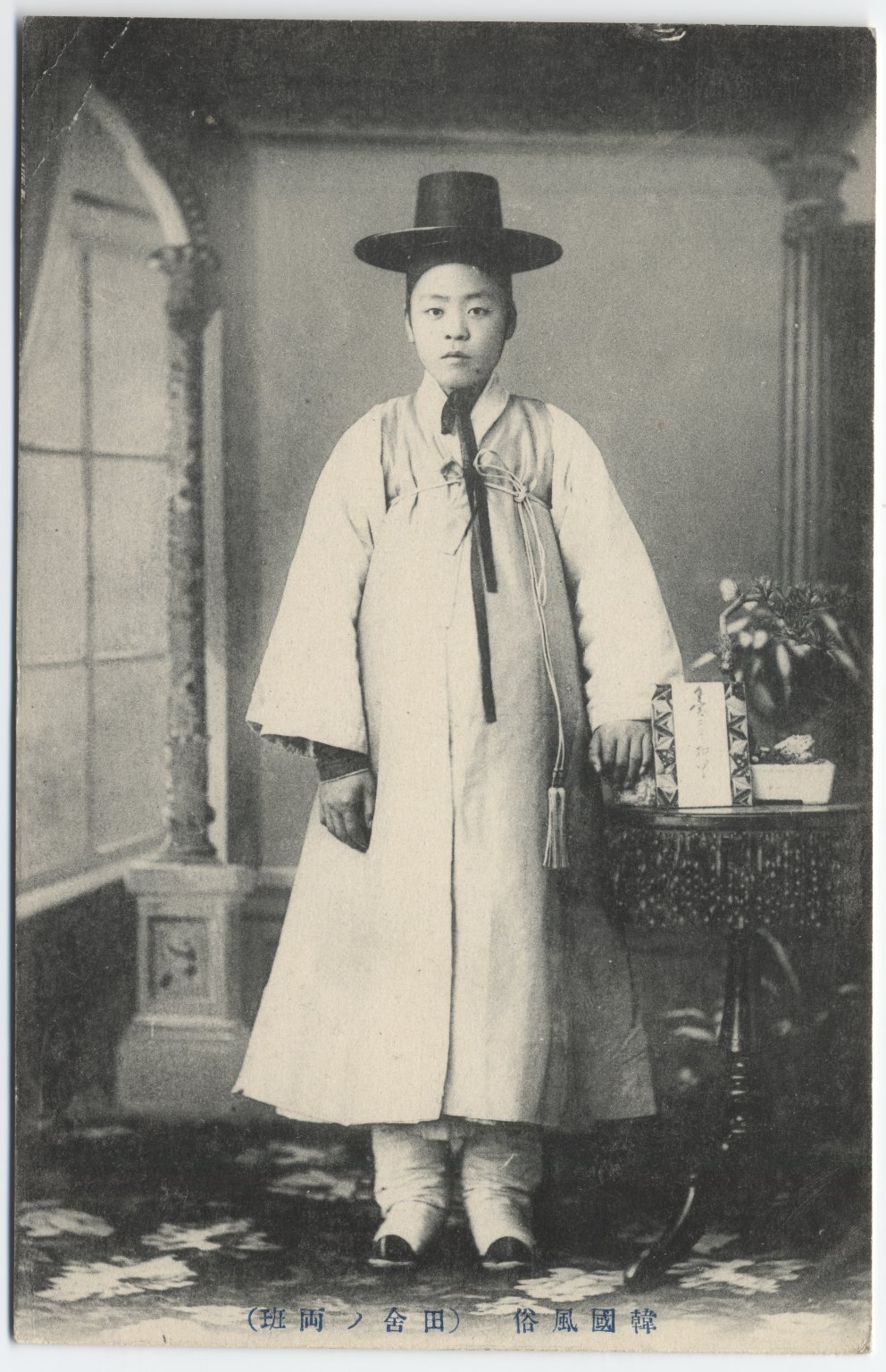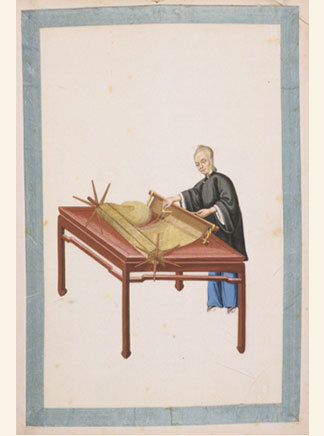|
Jang-ot
A jang-ot (장옷/長衣; lit. 'long gown'), also known as janot, jang-eui, jang-ui (장의/長衣), is a type of po worn by women of the Joseon Dynasty period as a headdress or veil to cover their faces by the mid-18th century. They were mostly worn by commoners but not exclusively. Jang-ot was originally a form of men's po called jang-ui, which was worn in 15th century. The jang-ui started to be worn by women as an overcoat in early Joseon, even becoming a popular fashion item for women of high status. It was previously one of the most representative women's overcoats; it was worn as a women's overcoat when they would leave their house until the 17th century. According to the principles of the Joseon Dynasty's Confucianism, women were ordered not to show their face to foreign men, so they would cover their faces in many ways while going out. The jang-ot became a headdress by the mid of the 18th century to conceal face and upper bodies when walking in public under this influen ... [...More Info...] [...Related Items...] OR: [Wikipedia] [Google] [Baidu] |
Po (clothing)
''Po'' is a generic term referring to an outer robe or overcoat. There are two general types of ''po'', the Korean type and the Paofu, Chinese type. The Korean type is a common style from the Three Kingdoms of Korea period, and it is used in modern day. A belt was used until it was replaced by a ribbon during late Joseon dynasty. ''Durumagi'' is a variety of ''po'' that was worn as protection against cold. It had been widely worn as an outer robe over ''jeogori'' and ''baji''. It is also called ''jumagui'', ''juchaui'', or ''juui''. The Chinese type is different styles of ''po'' from China. Starting from North-South states period, they were used through history until nation-wide adoption of the Korean type ''durumagi'' in 1895. Types * Changeui (창의, 氅衣) *Terlig, Cheollik *Round collar robe, Danryeongpo (단령포/團領袍) – a type of round collar robe, worn by men and women. *Dapho – a short sleeved overcoat. * Dopo (clothing), Dopo (도포/道袍) – a type o ... [...More Info...] [...Related Items...] OR: [Wikipedia] [Google] [Baidu] |
Korean Clothing-Jangot-01
Korean may refer to: People and culture * Koreans, ethnic group originating in the Korean Peninsula * Korean cuisine * Korean culture * Korean language **Korean alphabet, known as Hangul or Chosŏn'gŭl **Korean dialects and the Jeju language **See also: North–South differences in the Korean language Places * Korean Peninsula, a peninsula in East Asia * Korea, a region of East Asia * North Korea, the Democratic People's Republic of Korea * South Korea, the Republic of Korea Other uses *Korean Air, flag carrier and the largest airline of South Korea See also *Korean War, 1950–1953 war between North Korea and South Korea *Names of Korea, various country names used in international contexts *History of Korea The Lower Paleolithic era in the Korean Peninsula and Manchuria began roughly half a million years ago. Christopher J. Norton, "The Current State of Korean Paleoanthropology", (2000), ''Journal of Human Evolution'', 38: 803–825. The earlies ..., the history of Kor ... [...More Info...] [...Related Items...] OR: [Wikipedia] [Google] [Baidu] |
Baji (clothing)
Baji ( ko, 바지) is a kind of traditional Korean pant that is part of the hanbok. ''koreanculture''. Access date: June 9, 2010. A baji is baggy and loose, so it is tied around the waist. In the past, Korean men wore baji as outer , but for women
A woman is an adult female human. Prior to adulthood, a female human is referred to as a girl (a female child or adolescent). The plural ''women'' is sometimes used in certain phrases such as "women's rights" to denote female humans regardl ... , it gradually became part of the inner clothing. [...More Info...] [...Related Items...] OR: [Wikipedia] [Google] [Baidu] |
Jungin
The ''jungin'' or ''chungin'' () were the upper middle class of the Joseon Dynasty in medieval and early modern Korean society. The name "jungin" directly means "middle people". This privileged class of commoners consisted of a small group of petty bureaucrats and other highly educated skilled workers whose technical and administrative skills enabled the ''yangban'' and the royal family to rule the lower classes. ''Jungin'' were the lifeblood of the Korean Confucian agrarian bureaucracy, for whom the upper classes depended on to maintain their vice-like hold on the people. Their traditions and habits are the forerunners of the modern Korean administrative systems in both North and South Korea. Professions and roles in the society In dynastic Korea, particularly during the Joseon period, the ''jungin'' were lower than the ''yangban'' aristocracy but above the lower middle and working class commoners in social status. They included highly educated government-employed specialis ... [...More Info...] [...Related Items...] OR: [Wikipedia] [Google] [Baidu] |
Yangban
The ''yangban'' () were part of the traditional ruling class or gentry of dynastic Korea during the Joseon Dynasty. The ''yangban'' were mainly composed of highly educated civil servants and military officers—landed or unlanded aristocrats who individually exemplified the Korean Confucian form of a " scholarly official". They were largely government administrators and bureaucrats who oversaw medieval and early modern Korea's traditional agrarian bureaucracy until the end of the dynasty in 1897. In a broader sense, an office holder's family and descendants, as well as country families who claimed such descent, were socially accepted as ''yangban''. Overview Unlike noble titles in the European and Japanese aristocracies, which were conferred on a hereditary basis, the bureaucratic position of ''yangban'' was granted by law to ''yangban'' who meritoriously passed state-sponsored civil service exams called ''gwageo'' (). This exam was modeled on the imperial examinations first s ... [...More Info...] [...Related Items...] OR: [Wikipedia] [Google] [Baidu] |
Korea
Korea ( ko, 한국, or , ) is a peninsular region in East Asia. Since 1945, it has been divided at or near the 38th parallel, with North Korea (Democratic People's Republic of Korea) comprising its northern half and South Korea (Republic of Korea) comprising its southern half. Korea consists of the Korean Peninsula, Jeju Island, and several minor islands near the peninsula. The peninsula is bordered by China to the northwest and Russia to the northeast. It is separated from Japan to the east by the Korea Strait and the Sea of Japan (East Sea). During the first half of the 1st millennium, Korea was divided between three states, Goguryeo, Baekje, and Silla, together known as the Three Kingdoms of Korea. In the second half of the 1st millennium, Silla defeated and conquered Baekje and Goguryeo, leading to the "Unified Silla" period. Meanwhile, Balhae formed in the north, superseding former Goguryeo. Unified Silla eventually collapsed into three separate states due to ... [...More Info...] [...Related Items...] OR: [Wikipedia] [Google] [Baidu] |
Shroud
Shroud usually refers to an item, such as a cloth, that covers or protects some other object. The term is most often used in reference to ''burial sheets'', mound shroud, grave clothes, winding-cloths or winding-sheets, such as the famous Shroud of Turin, ''tachrichim'' (burial shrouds) that Jews are dressed in for burial, or the white cotton ''kaffan'' sheets Muslims are wrapped in for burial. A traditional Orthodox Jewish shroud consists of a tunic; a hood; pants that are extra-long and sewn shut at the bottom, so that separate foot coverings are not required; and a belt, which is tied in a knot shaped like the Hebrew letter ''shin'', mnemonic of one of God's names, Shaddai. Traditionally, mound shrouds are made of white cotton, wool or linen, though any material can be used so long as it is made of natural fibre. Intermixture of two or more such fibres is forbidden, a proscription that ultimately derives from the Torah, ''viz.'', Deut. 22:11. An especially pious Jewish ma ... [...More Info...] [...Related Items...] OR: [Wikipedia] [Google] [Baidu] |
Cotton
Cotton is a soft, fluffy staple fiber that grows in a boll, or protective case, around the seeds of the cotton plants of the genus ''Gossypium'' in the mallow family Malvaceae. The fiber is almost pure cellulose, and can contain minor percentages of waxes, fats, pectins, and water. Under natural conditions, the cotton bolls will increase the dispersal of the seeds. The plant is a shrub native to tropical and subtropical regions around the world, including the Americas, Africa, Egypt and India. The greatest diversity of wild cotton species is found in Mexico, followed by Australia and Africa. Cotton was independently domesticated in the Old and New Worlds. The fiber is most often spun into yarn or thread and used to make a soft, breathable, and durable textile. The use of cotton for fabric is known to date to prehistoric times; fragments of cotton fabric dated to the fifth millennium BC have been found in the Indus Valley civilization, as well as fabric remnants dated back ... [...More Info...] [...Related Items...] OR: [Wikipedia] [Google] [Baidu] |
Ramie
Ramie (pronounced: , ; from Malay ) is a flowering plant in the nettle family Urticaceae, native to eastern Asia. It is a herbaceous perennial growing to tall;Ramie: Old Fiber - New Image at the (September 17, 2002). [...More Info...] [...Related Items...] OR: [Wikipedia] [Google] [Baidu] |
Silk
Silk is a natural protein fiber, some forms of which can be woven into textiles. The protein fiber of silk is composed mainly of fibroin and is produced by certain insect larvae to form cocoons. The best-known silk is obtained from the cocoons of the larvae of the mulberry silkworm ''Bombyx mori'' reared in captivity (sericulture). The shimmering appearance of silk is due to the triangular prism-like structure of the silk fibre, which allows silk cloth to refract incoming light at different angles, thus producing different colors. Silk is produced by several insects; but, generally, only the silk of moth caterpillars has been used for textile manufacturing. There has been some research into other types of silk, which differ at the molecular level. Silk is mainly produced by the larvae of insects undergoing complete metamorphosis, but some insects, such as webspinners and raspy crickets, produce silk throughout their lives. Silk production also occurs in hymenoptera ( bee ... [...More Info...] [...Related Items...] OR: [Wikipedia] [Google] [Baidu] |






